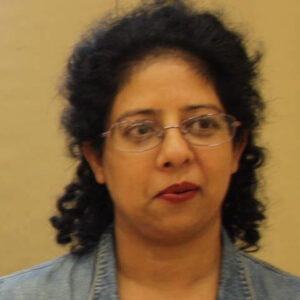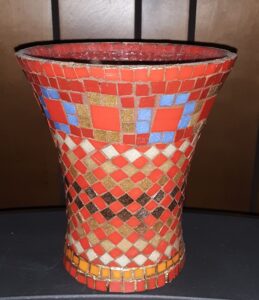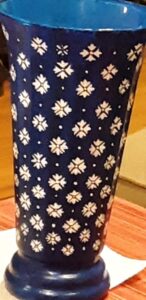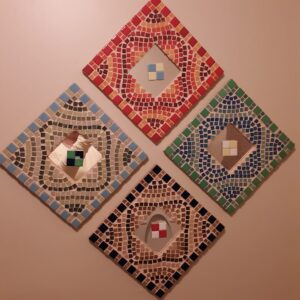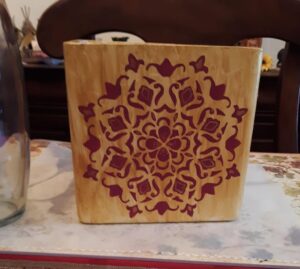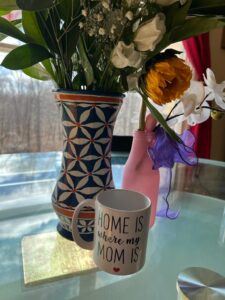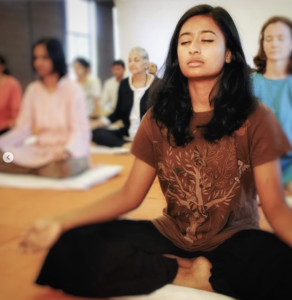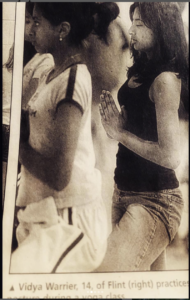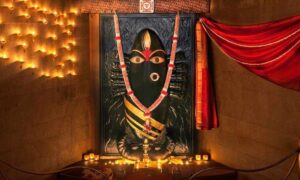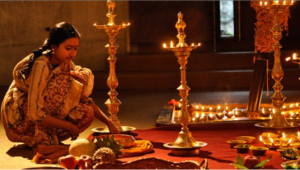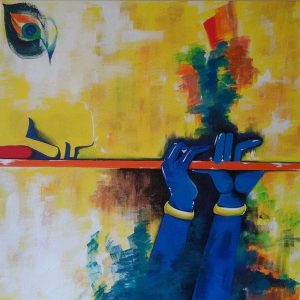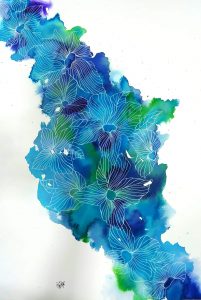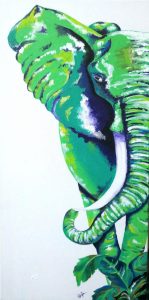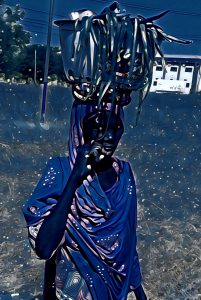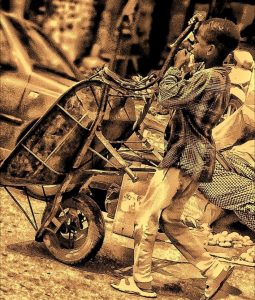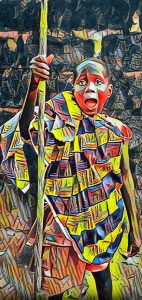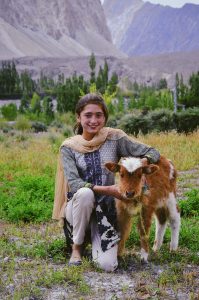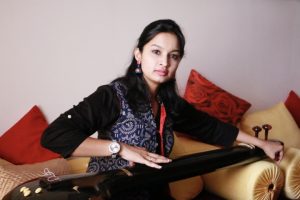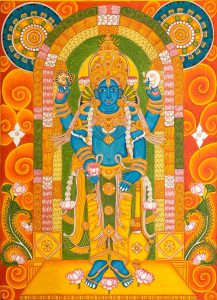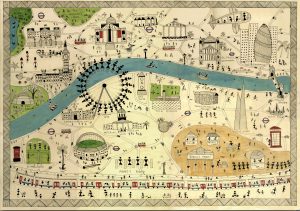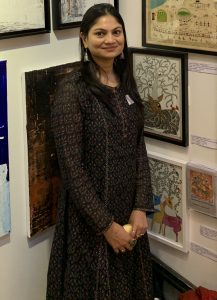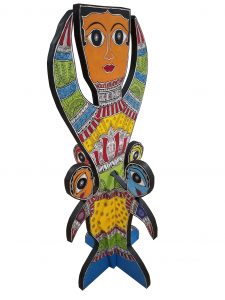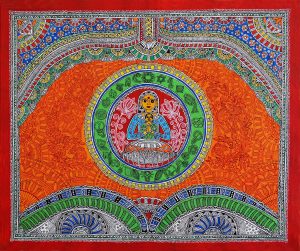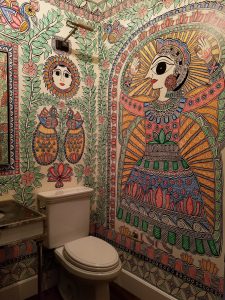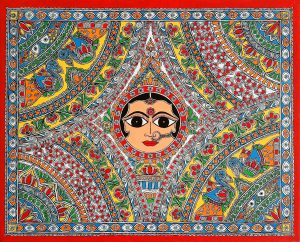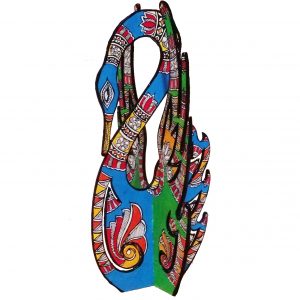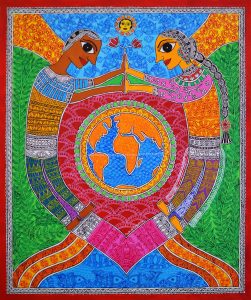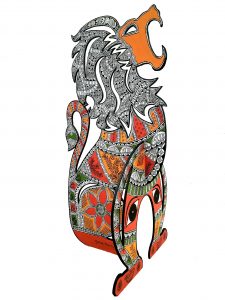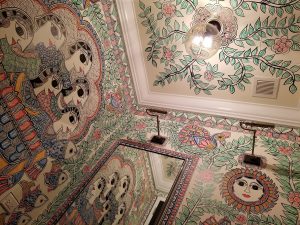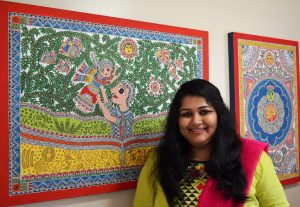Deepa Naidu
In this Fall 2022 edition of Jaggery Lit, our Arts Editor Srividya Ramamurthy had a wonderful conversation with Mrs. B. Deepa Naidu. Deepa Naidu completed B.E (Computer Science) from Sri Venkateswara College Of Engineering, Sriperumbudur, Tamil N?du, and later completed MS (Software Systems) from BITS, Pilani. Deepa had been working as an IT Professional for 22 years in Chennai and resigned the job in 2020 as a Senior IT Architect. Deepa’s passion for crafts started a decade back and after quitting IT, Deepa started nurturing her passion full time. She started her brand, TulipByDeepa, in 2019 which is her platform to take her interest to the next level. Her handmade products are made available under her brand name, and she has recently collaborated with Zwende to join the network of artisans and crafters.
With that quick intro on our visual artist for this edition, let’s dive into a conversation with Deepa. Her story will resonate with many of our readers.
Deepa, welcome to our Fall 2022 edition of Jaggery Lit. We are looking forward to hearing your foray from software programming to a more precise programming err… art and artistic creation that you are creating these days.
So please tell us from computers to art and hand work? Was arts and crafts something that has been with you since childhood?
I had absolutely nothing to do with any synonym of creativity/artistic until I reached the hardest phase of my career as an IT professional. There came a time when I started losing my work life balance, unable to juggle between professional and personal duties, which I believe is quite common among working women.
Absolutely. It is hard to balance for sure and I don’t think one ever gets to balance it in the truest sense of being balanced.
Smiles. Yes, however, this wasn’t the first time I came to hit that point, but I realized that this time I will definitely sink, if I don’t divert my mind onto something else to keep me going.
That must have been a tough phase and time then. What happened or what changed?
Well Motherhood happened and with a toddler at home there was never a dull moment. There were constant and moving deliverables between home and work. Long days and faster months was the constant theme.
Yep! I can relate to that.
So, at home there was always a need for storage boxes. To stow away the toys or books, you name it. Amazon was constantly delivering stuff home and my eyes were fixed on the plenty of amazon delivery boxes being thrown away. That was my spark, and I started reusing those boxes after wrapping them in colorful fabrics. They were perfect storage. The colors perked and added a smile to my face. I also gifted the surplus boxes to my friends/colleagues. That is how it all started. I thought I kept it going. However, the fact is it kept me going. It kept me away from drowning. I liked the new happy feeling.
Wonderful!!! Reuse, repurpose and what a great utility value. Amazing. I wonder why I didn’t think of this. Well, I am not Deepa, Am I? (Laughs)
Well, well. I don’t claim perfection in my amateur work, but every piece of my work is close to my heart, and it healed me.
Yes! Amazing. How did it take off from there?
I started a Facebook page in 2014 as a repository for my handmade work (www.facebook.com/deepasomewhereovertherainbow). This page speaks for me on all the learnings and experiments I had done over these years. On a gloomy day, I just visit this page and it lifts my spirits.








Have you had any formal training?
The only formal training I took was for Mahbubani art in 2021. This opened a whole new world for me, because until then I never thought I could draw.
And why would you say that?
Honestly, I was quite bad at doing my biology record work during school days. And that was my only entry to the world of drawing! And anything I did I was doing craft work which was a “googled/you-tubed” knowledge involving sewing, quilling, etc., but not drawing. So, when I enrolled in 2021, I was initially skeptical. Mahbubani is an artwork that involves drawing. But my arts teacher, Mrs.Visalam Ramalingam, encouraged me and after 3 months of training, I was quite happy with my skill. I then started experimenting on different mediums like bags, fabric, wall etc.


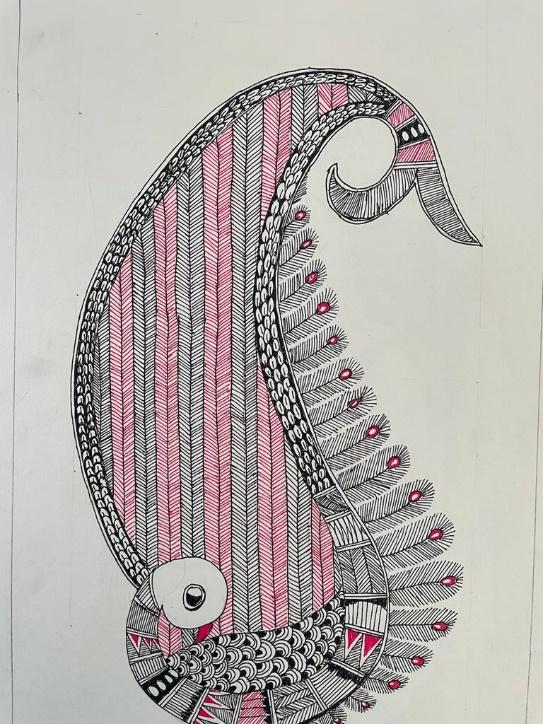

So, there was always an artist in you that was just discovered in 2021?
Well, you can say that now, I guess. (Smiles) I think social media has inspired a lot of that and for me to find out my own hidden talents. While I do like getting to have the nuances of an artwork, I have enjoyed, learnt, and been inspired by many artists that I follow on Instagram and Facebook. I also have similar inspiration in my friends/family circle. Beyond any of my own, the consistent motivation and encouragement provided by my friends/family helped me to explore more on my passion.
Yes, in some ways social media has democratized different avenues, I guess. Yours seem to be a useful use of social media which has led to your discovery of a creative side.
Agree! I feel the upside of not having formal training is that you learn from mistakes and those learnings are precious and you value it more. I guess what I mean is there is no grading process but your own self grading yourself. The downside is the time you take to master an art in learning every nuance by experimenting and retrying. I took my own sweet time in learning craft work all by myself because I wanted to experience what it is to not learn something through this methodology. Afterall, we spend the first 2 decades of our life through formal training…school, college, etc.…why not try a different methodology.
View this post on Instagram
Right?! We do spend a lot of time learning and relearning things in a structured education method. So, the year of 2014 was the starting point of all this. Can you give our readers how the bud bloomed?
Well, I started with simple craft works in 2014. Every craft product took several weeks of learning and experimenting. My passion grew exponentially, and I gave my craft works as gifts to my friends/colleagues/family-members.
The baby-steps to exhibit and sell the handmade crafts happened when I hosted a small stall in a school’s fun festival in 2019. I launched my platform, TulipByDeepa, in the same year and from thereon, there was no turning back. Juggling between profession and passion isn’t easy to deal with and there was a slow down on my craft activity at times.
A moment came when I decided to gracefully end my 22-yearlong affair with the IT field and focus on my passion. Here I am, doing what my heart says and trying to provide the best of handmade products.
You are one of the lucky ones. I must say. You seem to have found your calling and you have the freedom to pursue it also. How wonderful ! I have seen you do wonderful arts on the wall. How did that happen? A dull wall has perked up so bright and beautiful.
For wall art, my inspiration was from a couple of Brazilian wall muralists who I follow on Instagram. I was awestruck by seeing their free-hand drawings without any shaky lines and the choice of colors they used to bring out the life. I was equally inspired by the Chennai Street wall paintings that I used to gaze for a long time when passing through the streets.
So I experimented with my first wall painting thinking that it should not be a Hercules task, but I was terribly wrong. When you draw on a paper/fabric you can adjust the positioning of the medium at your hand’s convenience. But not a wall. Your body, head and hands have to do all the adjustment while the wall is stationary.
I painted 4 different walls, and I realized that a formal training is what I need for this activity before I touch any other walls at my home.


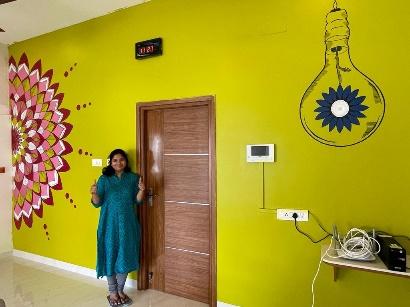

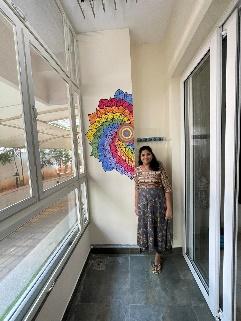
Well, that is interesting, It is almost a meditative focus one must have to do this on the walls I guess. I have always been in awe with the Kerala wall murals myself. What are the other things you do?
I do a variety of things. Things that can be given as gifts and making small things that are used in every household into something livelier and more colorful. I have done hand painted Tote bags, TeaLight/Dia holders with mandala/kolam patterns, Kolam Stools/Manais, Kolam Coasters, Kolam trays/pen stands/key holders.
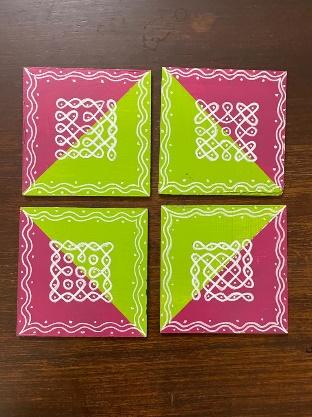

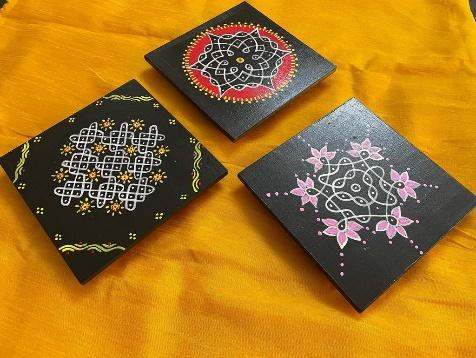

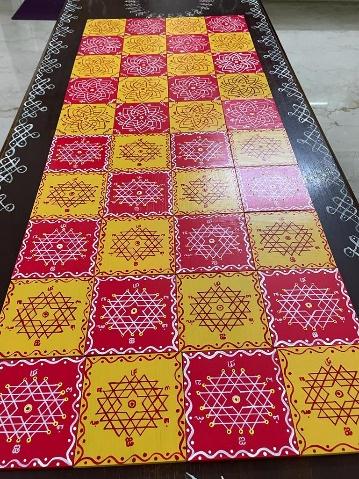




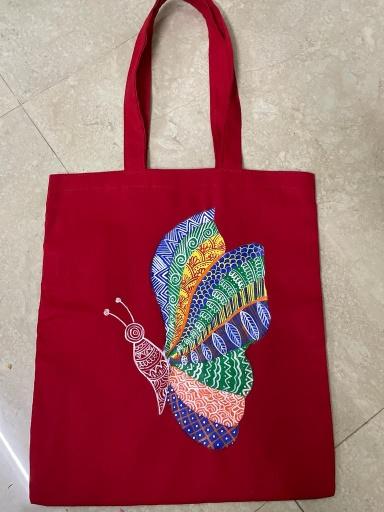
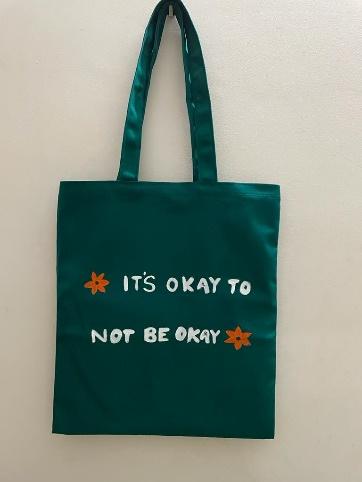
Deepa, all of these are truly fantastic. Geometry and designs that a simple Kolam (one can find these drawn every day in front of their homes in South of India and Sri Lanka) on a stool or tote bag. Love these! and they are all hand-made every one of them. How precious!!!
Do you sell these? How can people get in touch with you?
Yes, they are available for sale under my brand name, TulipByDeepa.
IG: @tulipbydeepa
FB: @tulipbydeepa
Email: tulipbydeepa@gmail.com
People can reach out to me for customizing the products based on their budget/need/design/color/etc.
Finally, I am sure your story would resonate with a lot of our readers. It resonated with me. There is always a fear of the unknown. And you seem to have found a way and a support system to back you always helps as well. However personally for you was the transition from IT profession to arts & crafts? Being a Computer Engineer, you left your comfort zone literally.
Yes! Transition wasn’t easy, and both are not to be compared, in my opinion. Every profession is unique. I can easily spell out umpteen differences between both professions but that is not the way to assess the career transition. I had a successful career for 22 years, with no regrets and an extreme job satisfaction for the expertise that I had. I did have my own challenges and difficult times, but those were a part and parcel of the job in any sector for anyone.
It has been 2+ years since I bid goodbye to my IT profession, and I started TulipByDeepa from level zero. I am a novice here in the world of arts & crafts. I have gone back to the age of learning something new; I will have to let myself endure this and enjoy this new change as well.
Well said Deepa. It was wonderful to get your perspective and have a lovely conversation with you. With Deepavali around the corner I am sure you are busy doing customized orders. Thank you for taking your time to talk with us at JaggeryLit. I wish you all the best.

